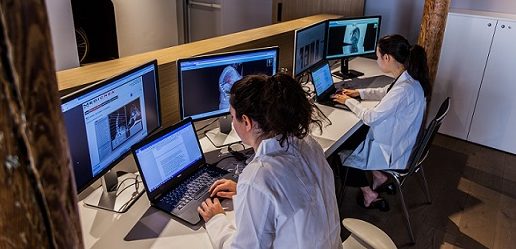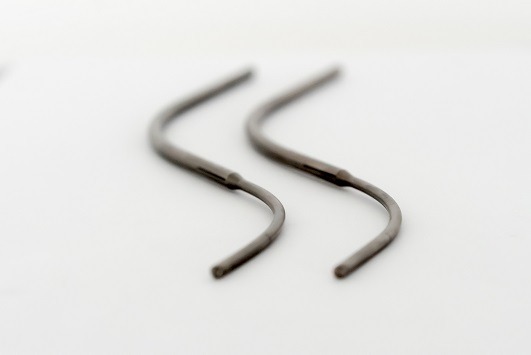
A team of researchers is planning a multicentre databank to track and evaluate the performance of personalised rods (UNiD Rod, Medicrea) in the treatment of scoliosis.
Manufactured according to individual patient imaging results using sophisticated planning software, anecdotal evidence suggests that the rods may improve variables from estimated blood loss to rod fracture. In fact, a new White Paper published this week has revealed very significant fracture reduction for personalised rods in comparison to traditional rods. The new databank may be able to offer data in support of these experiences.
Researchers and surgeons Evalina Burger and Christopher Kleck (both Colorado, USA) talk to Spinal News International about the new research project.
Please could you outline your team’s upcoming databank for evaluating the performance of personalised rods?
Evalina Burger: We have decided to start a multicentre databank, because if you collect data just as a study, when that study is done, then all of that data is kind of null and void. Once it is Institutional Review Board (IRB)-approved, we will be collecting large amounts of data now on patients—instead of just performing one study—seeing how many answers we can get from analysing the data.
We will be establishing a data bank from which we can then formulate studies. It is a little reverse-engineered, but I think that will work better at this point, because these personalised rods are really new and we want to see how they change results.
We may find that there is no change, but we do not yet know. That is why we are collecting a lot of data points, so we are sure that we cover all the bases. We are still working on finalising the data sheet so that we can perform a very robust, multicentre IRB, and then take it from there.

Why is this kind of data-gathering important?
EB: You need large data banks, with data-gathering over a lot of data points from multiple institutions and multiple surgeons, to validate the global impact of something. Otherwise, the can statistics get skewed. If it is a small dataset then the statistics are based on a projection versus an analysis.
Christopher Kleck: If you look at other orthopaedic fields like total joints, they have data registries and they have large databases with thousands of patients. This allows them to know when surgery is going to work or when it is not, what the appropriate surgery is and how best to perform it.
It is difficult in spine because there are so many surgeries and so many ways to do those surgeries, but, just because it is difficult, it does not mean we should not try.
The first step is actually setting up a database for collection. Once you get the data, who knows what it is going to show us? The important thing right now is actually trying to get that data first. Databases have the ability to help us direct surgeries; the way we do surgeries and who we select for surgery.
This database may help us stratify risk and determine who is going to have a better outcome. There are a lot of unanswered questions, and that is where—I think—“big data” will at least begin to help.
“For every individual patient we can plan the surgery preoperatively” – Christopher Kleck
How could this kind of “big data” analysis improve care on a patient-specific level?
CK: I think that this is an important point that we have been talking about a lot. Even though this is big data and we are trying to figure out how to treat spine issues in a categorical fashion, the UNiD Rods are still manufactured per patient.
For every individual patient we can plan the surgery preoperatively, using the personalised rod almost as a template—a way for us to measure achievement of our planned goals in the surgery. We may gather all this data as predictive analytics, but it still comes down to a case-by-case basis; taking each patient one-at-a-time and treating them appropriately for whatever their problem is.
Even though it sounds counterintuitive, the more data we have, the more it can drive individualised care.
Prior to this standardised data-gathering, what anecdotal differences are you aware of with treatment using personalised rods?
EB: One of the few anecdotal observations that we have made so far is that one size does not fit all. Most companies offer a variety of short, pre-bent rods in their set. But now, we have started to order shorter personalised rods. The radius of curvature is completely different from the usual sets, which are standardised across the globe.
When we get these rods, when you take a look at them, you notice that they are definitely not bent the way you would have expected. In my mind, I would have bent each rod into this perfect “S” shape that you see in textbooks of the thoracic and lumbar curves. These rods definitely do not look like this. In the beginning I was hesitant with them, asking myself, “is this the right thing?” But, actually, we are learning much more about the disease process now.
By using these rods, we are learning more and more about how the “diseased” spine actually works. Hopefully, our long-term outcomes and complication rates will go down, if we are able to balance diseased spines.
Balancing a diseased spine does not mean you make it like the picture in the book, and I think that is the disconnect that we have had. We all have this mind-frame of what the spine should look like, bending the rod to fit the spine. Now, we are fitting the spine to the rod.

Rod fracture rates are often high following scoliosis surgery. Do you think an improvement in fracture rates might be a potential benefit of pre-bent personalised rods?
CK: We can speculate. We need the data to actually back it up, but anecdotally we can say we have decreased rod fracture rates. For the spine community to accept this, we need to have the data to support it.
EB: Rod fracture can be caused by notching. If you keep on bending and re-bending rods in the same place, they can fracture. The best analogy is that of a coat hanger. If you take a wire hanger and you keep on twisting it, it breaks off. This is called metal fatigue, and is increased by the amount of time you bend it; there are actually microscopic cracks that occur in the metal, and that leaves to fatigue and it breaks.
Similarly, when bone does not heal and all of the weight is carried on the rod, the same thing can happen. Hopefully by taking away the repeated bending, that could contribute to a lower rate of fractures.
CK: Metals—when you bend them—have a kind of shape memory. All metals have it to a degree. So, if you take a straight rod and then bend it to accommodate a curve in the spine, over time we know that that rod will straighten somewhat. If you take a rod that has been specifically treated or bent in a certain way, then it may be more stable from a shape-memory standpoint.
In addition, we may have less of an issue with loss of correction over time because the metal is bending back to its original form.
“Personalised rods have led to a significant reduction in operative time for me” – Evalina Burger
How do you think personalisation will impact spine surgery more generally?
EB: I think this is a complete paradigm shift, and you either see the magic of this or you do not. The purpose of the databank and the studies we want to do is to educate our fellow surgeons on this.
Once you have used these personalised rods, you almost feel lost if you do not have it—it was that big of a paradigm shift for me. I did a case the other day without patient-specific rods, and I was—for a minute—almost lost, because I had to completely reverse my thinking.
Now I trust the rod as a template— I hold it and I think “I need to fix this and this.” In the past I would have fixed everything and then bent the rod, but now that almost seems archaic.
Personalised rods have led to a significant reduction in operative time for me, so I finish my cases earlier and with lower blood loss. It is an unbelievably helpful tool at this stage to do surgeries more eloquently, and I do not worry so much now when the patient is on the table that I did not get the balance correct.

CK: Everybody talks about the art of spine surgery, which I understand, but, at the same time there is a science to it. At the moment we have science in our preoperative planning, we have science in our postoperative evaluation, but intraoperative treatment is where we always talk about the art. These personalised rods are a template and a true scientific measure of what we are planning preoperatively with what we want to achieve postoperatively.
They can bring a little bit more science and a little bit more control into the operating room. It does take its own leap of faith, so it is a paradigm shift—you are trusting what you planned and that the rod is the shape that you want the spine to be, and really fitting the spine to the rod instead of vice versa—so it took us a little while.
We re-contoured the first rods that we put in, because we did not trust them. Those patients were the ones that did not come out as well-corrected as we wanted them to. So, it is going to take a change in mentality, I think, for spine surgery in general, from the idea that bending the rod is the “art” of spine surgery; that correction comes down to a keen eye.
If we can add this science to the mix, we should be able to standardise and improve outcomes. In the long run, this means better patient outcomes, better patient satisfaction, and overall better surgery.
Evalina Burger is a professor of orthopaedics and vice chair of the University of Colorado Spine Center, Aurora, USA. Christopher Kleck is an assistant professor at the same institution













